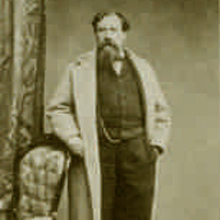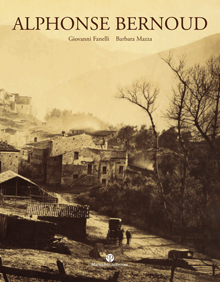Ricerca Veloce
Ricerca Avanzata
chiudi

Alphonse Bernoud
Jean Baptiste (noto come Alphonse) Bernoud (1820-1889) ha sviluppato la sua attività di fotografo in Italia tra la fine degli anni Quaranta – e dunque nella prima ora della storia della fotografia – e gli anni Settanta. Ha sperimentato abilmente varie tecniche e procedimenti, come il dagherrotipo, probabilmente il calotipo e poi ampiamente il collodio. Se non il primo – come gli piaceva affermare –, certo è stato fra i primi a saggiare e proporre le nuove tipologie di fotografia, quella stereoscopica e quella formato carta da visita, in Italia, dove è stato anche pioniere dell’organizzazione commerciale della fotografia.
Ha ritratto sovrani, politici, militari, diplomatici, attori, autori letterari, artisti, uomini di scienza. Si è dedicato in anticipo sui tempi alla documentazione dell’arte sia antica che contemporanea. Tuttavia l’aspetto che caratterizza peculiarmente la sua opera è la ripresa di eventi di attualità con i reportage: quello – contestato – dei paesi del salernitano e della Basilicata colpiti dal terremoto del dicembre 1857; della linea ferroviaria Firenze-Pistoia in costruzione (1859); delle truppe inviate in Toscana da Napoleone III (1859); dei caduti di Lissa; dell’assedio di Gaeta; dei briganti delle campagne meridionali; delle navi sarde, francesi, o inglesi nel porto di Napoli; dell’Esposizione Italiana del 1861; dell’inaugurazione del monumento a Dante in piazza Santa Croce a Firenze (1865).
Negli anni Sessanta e Settanta «L’illustration. Journal Universel» utilizzò alcuni suoi scatti per realizzare illustrazioni xilografiche di suoi articoli. Bernoud ha anche coltivato la fotografia di costume e di genere, contribuendo alla vasta produzione in questo campo interpretata a Napoli. Una parte non trascurabile della sua opera viene ricoperta dalla veduta di architettura e di spazi urbani – spesso animata –, rappresentata dalle vedute stereoscopiche. È da notare la sua attenzione per alcuni edifici e spazi urbani moderni (per esempio opere di Poccianti a Livorno, di Matas, di Villa o di Poggi a Firenze, di Marasca, Grasso, Francesconi e Bechi a Napoli).
All’inizio degli anni Settanta Bernoud lasciò l’Italia per tornare a Lione, dove operò soprattutto come ritrattista, realizzando anche una serie di soggetti botanici. In Italia i suoi atelier vennero ripresi da Achille Mauri a Napoli, dai fratelli Bartolena a Livorno, da Gustavo Matucci a Firenze.
Ha ritratto sovrani, politici, militari, diplomatici, attori, autori letterari, artisti, uomini di scienza. Si è dedicato in anticipo sui tempi alla documentazione dell’arte sia antica che contemporanea. Tuttavia l’aspetto che caratterizza peculiarmente la sua opera è la ripresa di eventi di attualità con i reportage: quello – contestato – dei paesi del salernitano e della Basilicata colpiti dal terremoto del dicembre 1857; della linea ferroviaria Firenze-Pistoia in costruzione (1859); delle truppe inviate in Toscana da Napoleone III (1859); dei caduti di Lissa; dell’assedio di Gaeta; dei briganti delle campagne meridionali; delle navi sarde, francesi, o inglesi nel porto di Napoli; dell’Esposizione Italiana del 1861; dell’inaugurazione del monumento a Dante in piazza Santa Croce a Firenze (1865).
Negli anni Sessanta e Settanta «L’illustration. Journal Universel» utilizzò alcuni suoi scatti per realizzare illustrazioni xilografiche di suoi articoli. Bernoud ha anche coltivato la fotografia di costume e di genere, contribuendo alla vasta produzione in questo campo interpretata a Napoli. Una parte non trascurabile della sua opera viene ricoperta dalla veduta di architettura e di spazi urbani – spesso animata –, rappresentata dalle vedute stereoscopiche. È da notare la sua attenzione per alcuni edifici e spazi urbani moderni (per esempio opere di Poccianti a Livorno, di Matas, di Villa o di Poggi a Firenze, di Marasca, Grasso, Francesconi e Bechi a Napoli).
All’inizio degli anni Settanta Bernoud lasciò l’Italia per tornare a Lione, dove operò soprattutto come ritrattista, realizzando anche una serie di soggetti botanici. In Italia i suoi atelier vennero ripresi da Achille Mauri a Napoli, dai fratelli Bartolena a Livorno, da Gustavo Matucci a Firenze.
Jean Baptiste (known as Alphonse) Bernoud (1820-1889) developed his activity as a photographer in Italy between the late 1940s - and thus in the first hour of the history of photography - and the 1970s. He skilfully experimented with various techniques and processes, such as the daguerreotype, probably the calotype and then widely the collodion. If not the first - as he liked to claim -, he was certainly among the first to test and propose the new types of photography, the stereoscopic and the business card format, in Italy, where he also pioneered the commercial organisation of photography.
He portrayed sovereigns, politicians, military personnel, diplomats, actors, literary authors, artists and men of science. He devoted himself ahead of his time to documenting both ancient and contemporary art. However, the most distinctive aspect of his work is the filming of current events with reportages: that - contested - of the towns of Salerno and Basilicata affected by the earthquake of December 1857; of the Florence-Pistoia railway line under construction (1859); of the troops sent to Tuscany by Napoleon III (1859); of the fallen of Lissa; of the siege of Gaeta; of the brigands of the southern countryside; of the Sardinian, French, or English ships in the port of Naples; of the Italian Exposition of 1861; of the inauguration of the monument to Dante in Piazza Santa Croce in Florence (1865).
In the 1960s and 1970s, 'L'illustration. Journal Universel' used some of his shots to make woodcut illustrations of his articles. Bernoud also cultivated costume and genre photography, contributing to the vast production in this field interpreted in Naples. A not insignificant part of his work is covered by the view of architecture and urban spaces - often animated - represented by stereoscopic views. It is worth noting his focus on certain modern buildings and urban spaces (e.g. works by Poccianti in Livorno, by Matas, Villa or Poggi in Florence, by Marasca, Grasso, Francesconi and Bechi in Naples).
In the early 1970s Bernoud left Italy to return to Lyon, where he worked mainly as a portrait painter, also producing a series of botanical subjects. In Italy, his studios were taken over by Achille Mauri in Naples, the Bartolena brothers in Livorno and Gustavo Matucci in Florence.
Vedi anche...
Alphonse Bernoud
- € 30,60
- € 36,00
